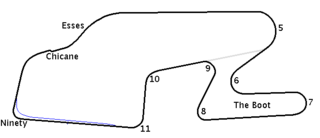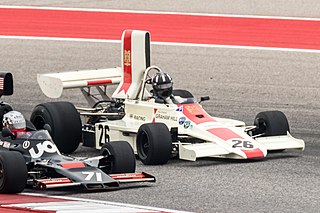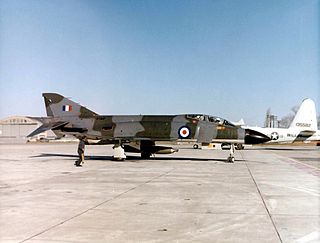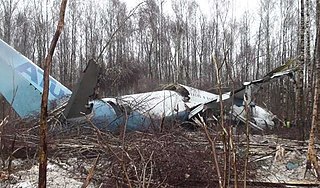
Norman Graham Hill was a British racing driver and team owner, who was the Formula One World Champion twice, winning in 1962 and 1968 as well as being runner-up on three occasions. Despite not passing his driving test until 1953 when he was already 24 years of age, and only entering the world of motorsports a year later, Hill went on to become one of the greatest drivers of his generation. Hill is most celebrated for being the only driver ever to win the Triple Crown of Motorsport, an achievement which he defined as winning the Indianapolis 500, the 24 Hours of Le Mans, and the Formula One World Drivers' Championship. While several of his peers have also espoused this definition, including fellow F1 World Champions Jacques Villeneuve, and Fernando Alonso, the achievement is today most commonly defined as including the Monaco Grand Prix rather than the Formula One World Championship. By this newer definition, Hill is still the only driver to have ever won the Triple Crown, winning at Monaco with such frequency in the 1960s that he became known as "Mr. Monaco". Hill crashed at the 1969 United States Grand Prix and was seriously injured, breaking both his legs and ending his season. Although he recovered and continued to race until 1975, Hill's career never again reached the same heights, and the Monaco Grand Prix victory earlier in 1969 was his last victory in Formula One.

The Piper PA-23, named Apache and later Aztec, is an American four- to six-seat twin-engined light aircraft aimed at the general aviation market. The United States Navy and military forces in other countries also used it in small numbers. Originally designed as the Twin Stinson in the 1950s by the Stinson Aircraft Company, Piper Aircraft manufactured the Apache and a more powerful version, the Aztec, in the United States from the 1950s to the 1980s.

The 1975 United States Grand Prix was a Formula One motor race held on October 5, 1975, at the Watkins Glen Grand Prix Race Course in Watkins Glen, New York. It was race 14 of 14 in both the 1975 World Championship of Drivers and the 1975 International Cup for Formula One Manufacturers. It was the 25th United States Grand Prix since the first American Grand Prize was held in 1908 and the 18th since the first United States Grand Prix at Riverside in 1958.
Anthony William Brise was an English racing driver, who took part in ten Formula One Grand Prix events in 1975, before dying in a plane crash with Graham Hill.
Embassy Racing With Graham Hill, commonly abbreviated to Embassy Hill, was a short-lived Formula One team started by two-time Formula One World Champion Graham Hill. The team debuted in 1973 with a customer Shadow DN1 car, and began racing as a constructor with its own chassis in 1975. The team had limited success in three seasons of racing, but everything was cut short by the death of Hill, Tony Brise and some of the team's top personnel in the crash of a light aircraft in the autumn before the 1976 season. The team was sponsored by Imperial Tobacco's Embassy cigarette brand and ran under various names during its time.

London Elstree Aerodrome is an operational general aviation aerodrome located in Elstree, and is situated 2.6 nautical miles east of Watford, Hertfordshire, England.

On March 4, 1966, Canadian Pacific Air Lines Flight 402 (CP402) struck the approach lights and a seawall during a night landing attempt in poor visibility at Haneda Airport in Tokyo, Japan. Of the 62 passengers and 10 crew, only 8 passengers survived.

Indian Airlines Flight 257 was an Indian Airlines domestic passenger flight operating on the Calcutta–Imphal–Dimapur route. On 16 August 1991, the Boeing 737-2A8 registered VT-EFL crashed into the hilly terrain of Thangjing Hill during its descent, killing all 63 passengers and 6 crew members on board.

The Hill GH1 was a Formula One car used by Embassy Hill during the 1975 Formula One season. It was designed by Andy Smallman. The car was initially designated as the Lola T371, but when Smallman left Lola to work full-time for Embassy Hill it was renamed as the Hill GH1. GH1 cars participated in 12 World Championship Grands Prix in 1975, with 21 entries in total using six different drivers. Two points finishes yielded 11th place in the World Constructors' Championship, with three points.

Arkley is a village in Greater London, England, within the London Borough of Barnet. It is located 10.6 miles (17.1 km) north-northwest of Charing Cross.

The 1974 Norfolk mid-air collision happened on 9 August 1974 at Fordham Fen, Norfolk, England when a Royal Air Force McDonnell-Douglas F-4M Phantom FGR.2 of No. 41 Squadron RAF collided with a Piper PA-25-235 Pawnee crop spraying aircraft. All three aviators were killed: the pilot and navigator of the Phantom and the pilot of the Pawnee. The Phantom pilot was a Royal Air Force Group Captain and station commander of RAF Coningsby. It was the first collision between a civil aircraft and a military fast jet in the United Kingdom low flying military training system.

On 6 January 1954 WJ474 a twin-engined Vickers Valetta training aircraft of No. 2 Air Navigation School Royal Air Force crashed near RAF Bovingdon just after takeoff in bad weather.

Aviastar-TU Flight 1906 was a Tupolev Tu-204 that crashed while attempting to land at Domodedovo International Airport, Moscow, Russia, in heavy fog on 22 March 2010. The aircraft was on a ferry flight from Hurghada International Airport, Egypt to Moscow, and had no passengers on board; all eight crew survived the accident, four with serious injuries requiring hospitalization and four with minor injuries. The accident was the first hull loss of a Tu-204 and the first hull loss for Aviastar-TU.

The 1950 Heathrow BEA Vickers Viking crash occurred on 31 October 1950 when a Vickers Viking operated by British European Airways (BEA) crashed at London Airport in heavy fog. The aircraft was on a scheduled flight between Paris and London's Northolt airport and 28 of the 30 passengers and crew on board were killed.

Two Air France Douglas DC-4 aircraft crashed two days apart in June 1950 within a few miles of each other and under similar circumstances. These two accidents, on 12 and 14 June, occurred while the aircraft were operating the same route from Saigon to Paris. Both aircraft had stopped at Karachi Airport and crashed into the sea on approach to Bahrain. A total of 86 passengers and crew were killed: 46 on June 12 and 40 on June 14. There were a total of 19 survivors: 6 on June 12 and 13 on June 14.

Court Line Aviation Flight 95 was an international charter flight from London Luton Airport, Bedfordshire, England, to Munich-Riem Airport, West Germany, operated on 18 April 1974 by Court Line BAC One-Eleven 518 G-AXMJ. During its take-off run, Piper PA-23 Aztec G-AYDE of McAlpine Aviation entered the active runway without permission. Although the pilots of the One-Eleven tried to take avoiding action, a collision between the two aircraft occurred, killing the pilot of the Aztec and injuring his passenger.

Air Bagan Flight 011 was a scheduled domestic passenger flight of a Fokker 100 twinjet from Yangon to Heho, Myanmar. On 25 December 2012, the aircraft crash-landed short of the runway at Heho Airport in fog, coming to a stop in a paddy field and bursting into flames. One of the 71 people on board and a motorcyclist on the ground were killed and more than 10 people were injured.

The 31 January 1971 Surgut Aeroflot Antonov An-12 crash occurred on 31 January 1971, when an Aeroflot Antonov An-12B, aircraft registration CCCP-12996, flying from Roshchino International Airport, Tyumen, in the Soviet Union's Russian Soviet Federated Socialist Republic (RSFSR), crashed 13.6 km (8.5 mi) short of the runway on approach to Surgut International Airport, Surgut, RSFSR. An investigation found the aircraft's loss of control was caused by icing.

Aeroflot Flight 101/X-20 was a scheduled domestic passenger flight from Moscow to Alma-Ata via Omsk, Soviet Union, that crashed in low visibility conditions on 4 January 1965, killing 64 of the 103 people on board.


















